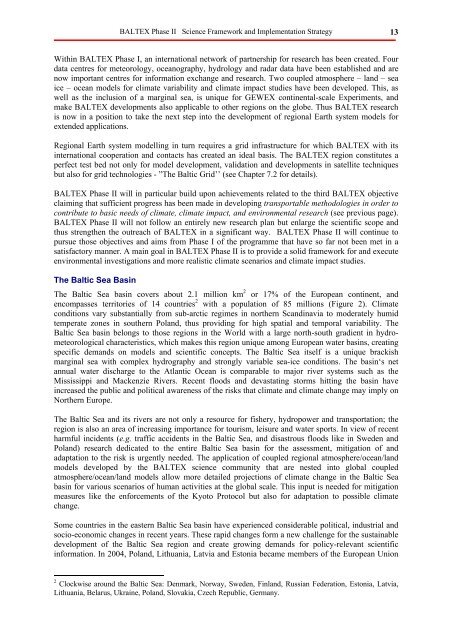BALTEX Phase II 2003 â 2012. Science Framework and ...
BALTEX Phase II 2003 â 2012. Science Framework and ...
BALTEX Phase II 2003 â 2012. Science Framework and ...
You also want an ePaper? Increase the reach of your titles
YUMPU automatically turns print PDFs into web optimized ePapers that Google loves.
<strong>BALTEX</strong> <strong>Phase</strong> <strong>II</strong> <strong>Science</strong> <strong>Framework</strong> <strong>and</strong> Implementation Strategy 13<br />
Within <strong>BALTEX</strong> <strong>Phase</strong> I, an international network of partnership for research has been created. Four<br />
data centres for meteorology, oceanography, hydrology <strong>and</strong> radar data have been established <strong>and</strong> are<br />
now important centres for information exchange <strong>and</strong> research. Two coupled atmosphere – l<strong>and</strong> – sea<br />
ice – ocean models for climate variability <strong>and</strong> climate impact studies have been developed. This, as<br />
well as the inclusion of a marginal sea, is unique for GEWEX continental-scale Experiments, <strong>and</strong><br />
make <strong>BALTEX</strong> developments also applicable to other regions on the globe. Thus <strong>BALTEX</strong> research<br />
is now in a position to take the next step into the development of regional Earth system models for<br />
extended applications.<br />
Regional Earth system modelling in turn requires a grid infrastructure for which <strong>BALTEX</strong> with its<br />
international cooperation <strong>and</strong> contacts has created an ideal basis. The <strong>BALTEX</strong> region constitutes a<br />
perfect test bed not only for model development, validation <strong>and</strong> developments in satellite techniques<br />
but also for grid technologies - ”The Baltic Grid’’ (see Chapter 7.2 for details).<br />
<strong>BALTEX</strong> <strong>Phase</strong> <strong>II</strong> will in particular build upon achievements related to the third <strong>BALTEX</strong> objective<br />
claiming that sufficient progress has been made in developing transportable methodologies in order to<br />
contribute to basic needs of climate, climate impact, <strong>and</strong> environmental research (see previous page).<br />
<strong>BALTEX</strong> <strong>Phase</strong> <strong>II</strong> will not follow an entirely new research plan but enlarge the scientific scope <strong>and</strong><br />
thus strengthen the outreach of <strong>BALTEX</strong> in a significant way. <strong>BALTEX</strong> <strong>Phase</strong> <strong>II</strong> will continue to<br />
pursue those objectives <strong>and</strong> aims from <strong>Phase</strong> I of the programme that have so far not been met in a<br />
satisfactory manner. A main goal in <strong>BALTEX</strong> <strong>Phase</strong> <strong>II</strong> is to provide a solid framework for <strong>and</strong> execute<br />
environmental investigations <strong>and</strong> more realistic climate scenarios <strong>and</strong> climate impact studies.<br />
The Baltic Sea Basin<br />
The Baltic Sea basin covers about 2.1 million km 2 or 17% of the European continent, <strong>and</strong><br />
encompasses territories of 14 countries 2 with a population of 85 millions (Figure 2). Climate<br />
conditions vary substantially from sub-arctic regimes in northern Sc<strong>and</strong>inavia to moderately humid<br />
temperate zones in southern Pol<strong>and</strong>, thus providing for high spatial <strong>and</strong> temporal variability. The<br />
Baltic Sea basin belongs to those regions in the World with a large north-south gradient in hydrometeorological<br />
characteristics, which makes this region unique among European water basins, creating<br />
specific dem<strong>and</strong>s on models <strong>and</strong> scientific concepts. The Baltic Sea itself is a unique brackish<br />
marginal sea with complex hydrography <strong>and</strong> strongly variable sea-ice conditions. The basin‘s net<br />
annual water discharge to the Atlantic Ocean is comparable to major river systems such as the<br />
Mississippi <strong>and</strong> Mackenzie Rivers. Recent floods <strong>and</strong> devastating storms hitting the basin have<br />
increased the public <strong>and</strong> political awareness of the risks that climate <strong>and</strong> climate change may imply on<br />
Northern Europe.<br />
The Baltic Sea <strong>and</strong> its rivers are not only a resource for fishery, hydropower <strong>and</strong> transportation; the<br />
region is also an area of increasing importance for tourism, leisure <strong>and</strong> water sports. In view of recent<br />
harmful incidents (e.g. traffic accidents in the Baltic Sea, <strong>and</strong> disastrous floods like in Sweden <strong>and</strong><br />
Pol<strong>and</strong>) research dedicated to the entire Baltic Sea basin for the assessment, mitigation of <strong>and</strong><br />
adaptation to the risk is urgently needed. The application of coupled regional atmosphere/ocean/l<strong>and</strong><br />
models developed by the <strong>BALTEX</strong> science community that are nested into global coupled<br />
atmosphere/ocean/l<strong>and</strong> models allow more detailed projections of climate change in the Baltic Sea<br />
basin for various scenarios of human activities at the global scale. This input is needed for mitigation<br />
measures like the enforcements of the Kyoto Protocol but also for adaptation to possible climate<br />
change.<br />
Some countries in the eastern Baltic Sea basin have experienced considerable political, industrial <strong>and</strong><br />
socio-economic changes in recent years. These rapid changes form a new challenge for the sustainable<br />
development of the Baltic Sea region <strong>and</strong> create growing dem<strong>and</strong>s for policy-relevant scientific<br />
information. In 2004, Pol<strong>and</strong>, Lithuania, Latvia <strong>and</strong> Estonia became members of the European Union<br />
2 Clockwise around the Baltic Sea: Denmark, Norway, Sweden, Finl<strong>and</strong>, Russian Federation, Estonia, Latvia,<br />
Lithuania, Belarus, Ukraine, Pol<strong>and</strong>, Slovakia, Czech Republic, Germany.













